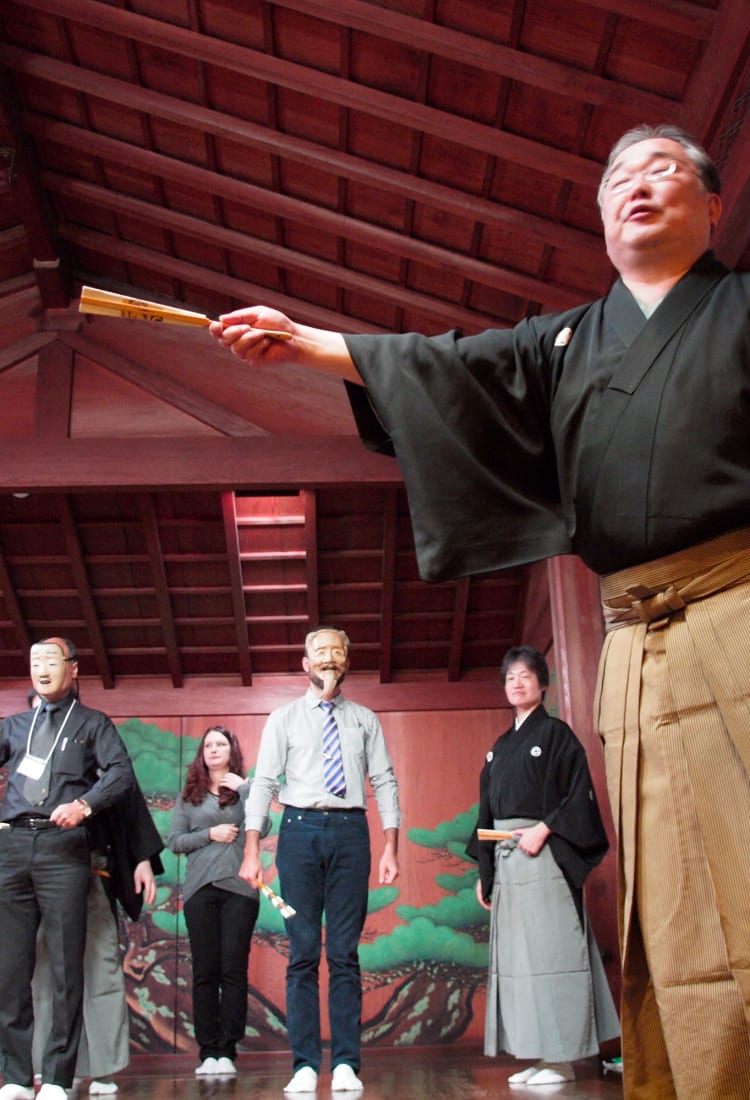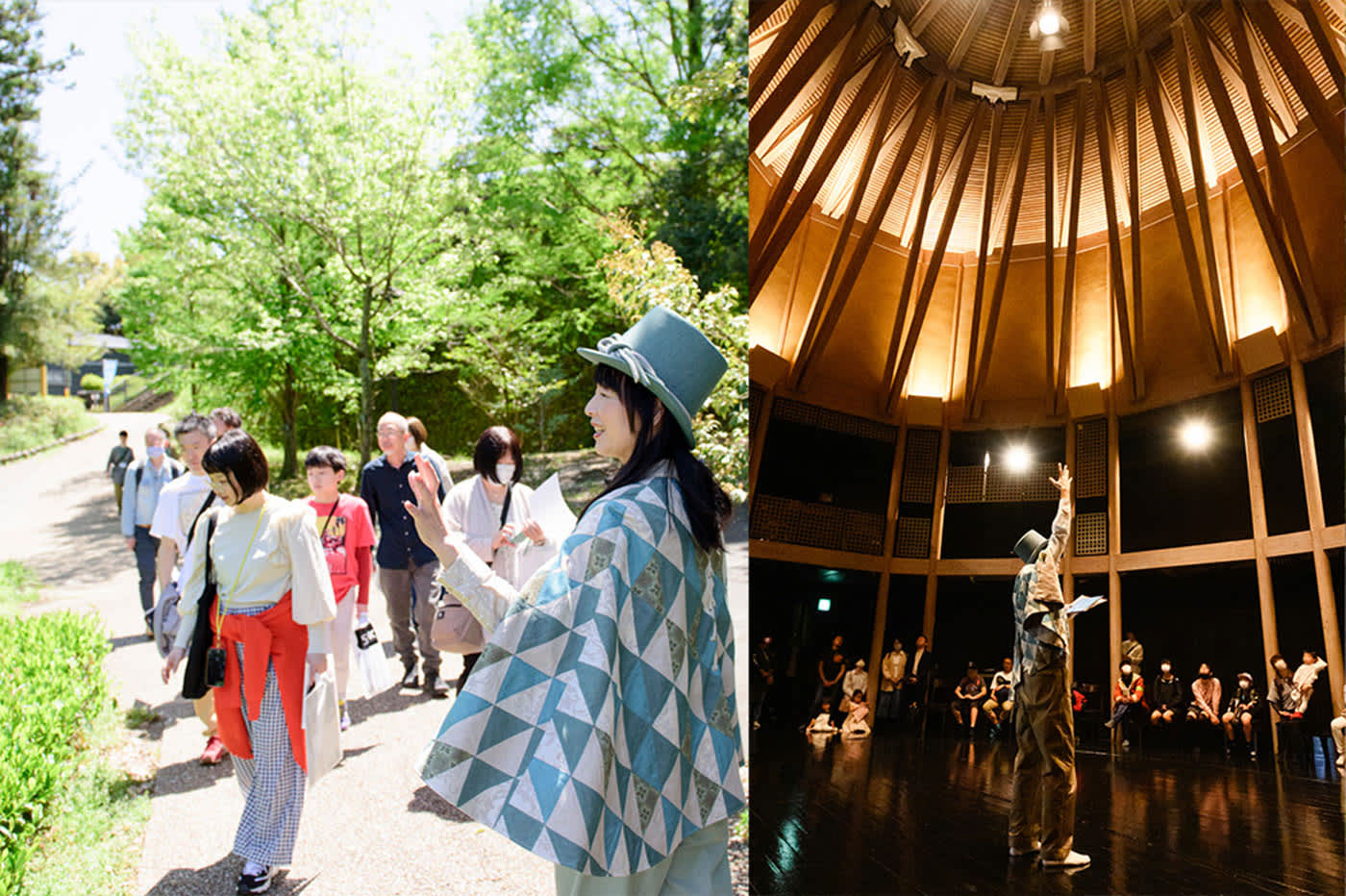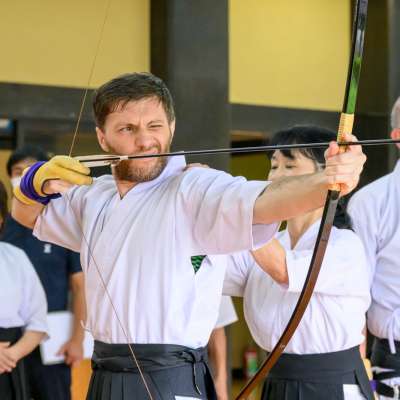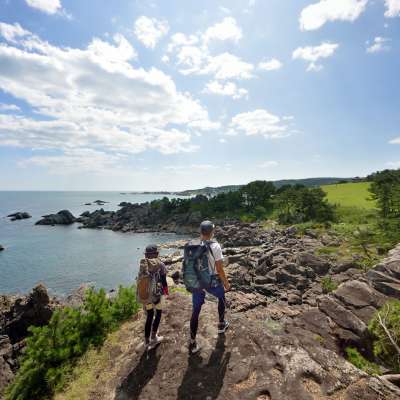
2024.11 Japanese Traditional Performing Arts: Hands-On Cultural Experiences Go behind the scenes, join workshops, and watch live performances
Explore Nature and Ryukyuan Traditions

Okinawa combines stunning natural landscapes with rich cultural experiences.
Photo: ©︎ Onna Tourisum Association
In Okinawa Prefecture, where temperatures are warm all year round, visitors have the opportunity to try some of the region’s traditional cultural experiences while enjoying the paradise-like natural surroundings. Onna Village, on the West Coast of Okinawa’s main island, is located near the Blue Cave, a famous spot for diving and snorkeling filled with blue light that reflects off the white sea floor.

Visit Okinawa’s Blue Cave, a famous sport for diving.
Photo: ©︎ Onna Tourisum Association
However, it’s not just marine sports that are on offer in Onna. One of the cultural experiences visitors can try includes learning to play the Sanshin – a traditional three-stringed instrument that produces a sound synonymous with Okinawan music, similar to a Shamisen.
In addition to Sanshin lessons, visitors have the opportunity to wear an Okinawan ryusou, which is airier and lighter to wear than a traditional Japanese kimono. Visitors can also participate in a Ryukyu Dance class. Ryukyu Dance is a traditional Okinawan dance with a rich history tied to the island's unique cultural and historical influences. Within Ryukyu Dance, there are different categories of performances – Traditional Dance, Zo Dance, and Creative Dance.

Watch a traditional Ryukyu dance in Okinawa.
The Traditional Dance of Okinawa dates back to the Ryukyu Kingdom era, where it was performed for royalty and visiting envoys for nearly 450 years, from the mid-15th century until political power was restored to the Emperor in 1867. After the abolition of the han system and the creation of prefectures in 1879, a new style called "Zou Odori" emerged, blending the music and culture of the people with traditional Ryukyu dance. This lively dance became a key part of festivals and celebrations. In contrast, Creative Dance incorporates modern choreography while preserving traditional elements, reflecting the fusion of contemporary and Okinawan culture.
At the National Theatre Okinawa, visitors can experience a Kumiodori performance, a traditional theatrical art form that blends singing, dancing, and spoken words. Once regarded as the highest form of entertainment for welcoming Chinese imperial envoys, Kumiodori holds a prestigious place in Okinawan culture and is recognized on UNESCO’s Representative List of the Intangible Cultural Heritage of Humanity.
Cultural Explorations in Osaka

Osaka Castle has a rich history waiting to be discovered.
While many people associate cities like Kyoto with traditional Japanese culture, neighboring city Osaka also has much to offer visitors when it comes to traditional culture and performing arts. Osaka Castle serves as the perfect introduction to the city’s more traditional side and is a must-visit attraction for anyone interested in Japanese history. Its history dates back to 1583 when a powerful feudal lord and samurai warrior called Hideyoshi Toyotomi ordered its construction during a period of unrest known as the Sengoku Civil War Period. Numerous wars broke out following the construction of Osaka Castle, and the structure was destroyed and rebuilt several times.
Inside, the castle has been transformed into a museum that showcases cultural artifacts and chronicles its rich, storied history through the Toyotomi and Tokugawa eras.

Stunning nature at Minoo Park, just a short train ride from Osaka.
Less than 30 minutes by train from Osaka Umeda Station, Minoo Park offers a peaceful escape into nature near the city. Home to Minoo Waterfall, a breathtaking waterfall with a height of 33 meters, the park features a scenic three-kilometer hike from nearby Minoo Station. The park is free to enter and is especially popular in the fall when visitors flock to see the waterfall framed by vibrant autumn foliage. Minoo Park is a must-see spot to easily combine with downtown Osaka and Osaka Castle.

Discover the performing art of Noh – blending song, dance, and narrator.
In Osaka Prefecture, visitors can experience traditional culture at the Yamamoto Noh Theater which participates in theater tours and Noh workshops.
Originating around 700 years ago, Nohgaku (Noh) is believed to be the oldest extant masque-type entertainment in the world with mixed elements of dancing, music, drama, and poetry. It was also Japan’s first Intangible Cultural Heritage designated by UNESCO.
Noh is a theatrical performance that expresses the inner movements of the mind with restrained movement, dancing, utai chanting and hayashi musical accompaniment. Hayashi is made up of four instruments including fue (flute), kotsuzumi (shoulder drum), otsuzumi (hip drum), and taiko (stick drum).
Performed on a simple stage with hardly any background setting, Noh acting, minimized to the most possible extent, invites the audience to exercise their imagination.
In addition to the performance, each Noh mask or costume also captivates the audience with its artistic excellence. Noh has also greatly influenced other Japanese cultural aspects, including Kabuki and Bunraku, which appeared in later years.
It was in the early 15th century, more than 200 years before the days of Shakespeare, when Ze’ami, who brought Noh to completion, compiled his original dramaturgy.

Try dressing up as a character in a traditional Noh performance.
The workshop at the Yamamoto Noh Theater allows visitors the chance to put on masks and costumes of Noh that have entertained Japanese people for centuries and learning more about the movement and instruments used during performances.

Discover the traditional art of Bunraku at the National Bunraku Theatre.
At the National Bunraku Theatre in Osaka, visitors are invited to watch a Bunraku Performance for Beginners, a show that introduces the traditional performing art of Bunraku to new audiences. Bunraku is a traditional Japanese puppet theater performance that consists of three elements – a narrator, a shamisen player to provide musical accompaniment, and three puppeteers who cooperate to maneuver a single puppet.
The Bunraku puppets used in performances are visually striking and can weigh over 10 kilograms. Crafted primarily from wood, these dolls feature interchangeable heads to play different characters. Each head is equipped with a mechanism that allows the puppeteers to manipulate facial expressions, such as eye and mouth movements, adding a level of realism to the performance. The history of Bunraku dates back more than 300 years and is registered as a UNESCO Intangible Cultural Heritage. Several times during the year, special events are held for overseas tourists. During these events, the Bunraku performance also includes a special presentation where a performer explains the techniques and charms of Bunraku. Check the official website in advance for dates.
Art Meets Nature with Views of Mt. Fuji

Marvel at Mt. Fuji from the Shizuoka Performing Arts Park.
Shizuoka Prefecture is best known for its iconic Mt. Fuji, tea fields, and beautiful natural landscapes. As a major center for green tea production, visitors can explore tea farms, participate in tea-picking experiences, and enjoy the region’s tea culture. The city of Shizuoka also has a rich history, having been the childhood home of Tokugawa Ieyasu, the founder of the Tokugawa Shogunate.

Enjoy outdoor theater performances in scenic surroundings in April and May.
The Shizuoka Performing Arts Park is an expansive park located in the hills of Shizuoka Prefecture where nature and performing arts coexist, and Mt. Fuji serves as a majestic backdrop. Whilst many people visit the park to take a walk or a hike, there are also several buildings dedicated to the arts.
The park has three theaters for visitors to discover including an outdoor theater, an indoor theater, and the rehearsal building called Box Theater. The park's rest area and café have also been renovated to become the Mini Museum of the World Theatre 'Theatron'. This space is designed to introduce the history of theaters from around the world, spanning ancient times to the present day.
The park's DAENDO theater has an almost mystical ambiance with its pitch-black stage and light streaming from a domed ceiling. Meanwhile, the second-floor lounge offers spectacular views of Mt. Fuji in this hidden gem of a viewing spot.
The outdoor UDO theater, designed in the style of an ancient Greek amphitheater, is a striking example of art harmoniously blending with nature. An additional theater is also located in the park’s Rehearsal Hall building and consists of a simple black box where seating and stage can be arranged easily to create a versatile space.

Enjoy modern theatrical performances at the Shizuoka Performing Arts Park and Shizuoka Arts Theatre.
Each year from April to May, Shizuoka hosts a popular theater festival that attracts performers from around the world, alongside talented performers from Japan. In addition to its dedicated theater spaces, the festival transforms much of the Shizuoka area into a global stage for diverse performances.

Book a Theatre Tour at Shizuoka Arts Theatre and watch masterpiece productions.
Photo: F4,5 Makita Natsumi
Inside the park, the Theatre Tours are also available to book at any time on the official website. At the Shizuoka Arts Theatre, world-famous masterpieces are performed with modern productions from autumn to spring, and can be enjoyed with subtitles.
Introduction to the Japan Cultural Expo
The Japan Cultural Expo is an initiative of the Japanese government to enhance the appeal of Japanese arts and culture. Our mission is to encourage people to discover the charm of Japanese culture while enjoying programs of cultural content, including art exhibitions, performing arts, and art festivals.
Led by the Agency for Cultural Affairs and the Japan Arts Council, it is a collaborative, inter-agency project drawing on the cooperation of numerous public and private sector partners.
The Japan Cultural Expo website is a helpful source of information that introduces visitors to places around Japan where they can find information about cultural experiences. Japan’s traditional performing arts offer more than just performances. They provide an immersive journey into the heart of the country’s rich culture, where visitors can engage with centuries-old traditions. These experiences can create lasting memories for visitors and a deeper appreciation for Japan’s unique cultural heritage.
Information
JAPAN CULTURAL EXPO 2.0 |
























































